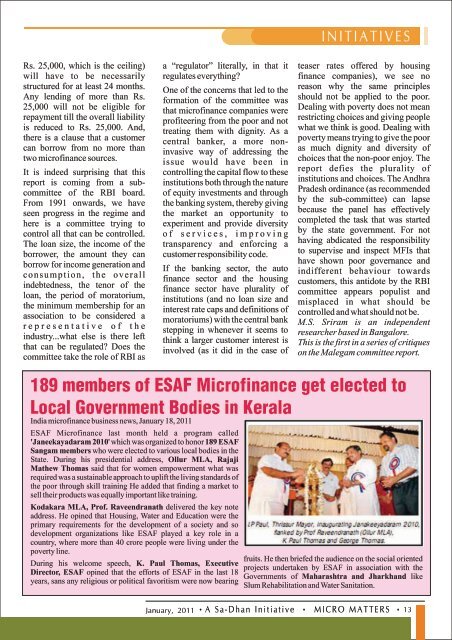Micro Finance Matters-JANUARY 2011 - Sa-Dhan
Micro Finance Matters-JANUARY 2011 - Sa-Dhan
Micro Finance Matters-JANUARY 2011 - Sa-Dhan
You also want an ePaper? Increase the reach of your titles
YUMPU automatically turns print PDFs into web optimized ePapers that Google loves.
Rs. 25,000, which is the ceiling)<br />
will have to be necessarily<br />
structured for at least 24 months.<br />
Any lending of more than Rs.<br />
25,000 will not be eligible for<br />
repayment till the overall liability<br />
is reduced to Rs. 25,000. And,<br />
there is a clause that a customer<br />
can borrow from no more than<br />
two microfinance sources.<br />
It is indeed surprising that this<br />
report is coming from a subcommittee<br />
of the RBI board.<br />
From 1991 onwards, we have<br />
seen progress in the regime and<br />
here is a committee trying to<br />
control all that can be controlled.<br />
The loan size, the income of the<br />
borrower, the amount they can<br />
borrow for income generation and<br />
consumption, the overall<br />
indebtedness, the tenor of the<br />
loan, the period of moratorium,<br />
the minimum membership for an<br />
association to be considered a<br />
r e p r e s e n t a t i v e o f t h e<br />
industry...what else is there left<br />
that can be regulated Does the<br />
committee take the role of RBI as<br />
a “regulator” literally, in that it<br />
regulates everything<br />
One of the concerns that led to the<br />
formation of the committee was<br />
that microfinance companies were<br />
profiteering from the poor and not<br />
treating them with dignity. As a<br />
central banker, a more noninvasive<br />
way of addressing the<br />
issue would have been in<br />
controlling the capital flow to these<br />
institutions both through the nature<br />
of equity investments and through<br />
the banking system, thereby giving<br />
the market an opportunity to<br />
experiment and provide diversity<br />
o f s e r v i c e s , i m p r o v i n g<br />
transparency and enforcing a<br />
customer responsibility code.<br />
If the banking sector, the auto<br />
finance sector and the housing<br />
finance sector have plurality of<br />
institutions (and no loan size and<br />
interest rate caps and definitions of<br />
moratoriums) with the central bank<br />
stepping in whenever it seems to<br />
think a larger customer interest is<br />
involved (as it did in the case of<br />
teaser rates offered by housing<br />
finance companies), we see no<br />
reason why the same principles<br />
should not be applied to the poor.<br />
Dealing with poverty does not mean<br />
restricting choices and giving people<br />
what we think is good. Dealing with<br />
poverty means trying to give the poor<br />
as much dignity and diversity of<br />
choices that the non-poor enjoy. The<br />
report defies the plurality of<br />
institutions and choices. The Andhra<br />
Pradesh ordinance (as recommended<br />
by the sub-committee) can lapse<br />
because the panel has effectively<br />
completed the task that was started<br />
by the state government. For not<br />
having abdicated the responsibility<br />
to supervise and inspect MFIs that<br />
have shown poor governance and<br />
indifferent behaviour towards<br />
customers, this antidote by the RBI<br />
committee appears populist and<br />
misplaced in what should be<br />
controlled and what should not be.<br />
M.S. Sriram is an independent<br />
researcher based in Bangalore.<br />
This is the first in a series of critiques<br />
on the Malegam committee report.<br />
189 members of ESAF <strong>Micro</strong>finance get elected to<br />
Local Government Bodies in Kerala<br />
India microfinance business news, January 18, <strong>2011</strong><br />
ESAF <strong>Micro</strong>finance last month held a program called<br />
'Janeekayadaram 2010' which was organized to honor 189 ESAF<br />
<strong>Sa</strong>ngam members who were elected to various local bodies in the<br />
State. During his presidential address, Ollur MLA, Rajaji<br />
Mathew Thomas said that for women empowerment what was<br />
required was a sustainable approach to uplift the living standards of<br />
the poor through skill training He added that finding a market to<br />
sell their products was equally important like training.<br />
Kodakara MLA, Prof. Raveendranath delivered the key note<br />
address. He opined that Housing, Water and Education were the<br />
primary requirements for the development of a society and so<br />
development organizations like ESAF played a key role in a<br />
country, where more than 40 crore people were living under the<br />
poverty line.<br />
During his welcome speech, K. Paul Thomas, Executive<br />
Director, ESAF opined that the efforts of ESAF in the last 18<br />
years, sans any religious or political favoritism were now bearing<br />
fruits. He then briefed the audience on the social oriented<br />
projects undertaken by ESAF in association with the<br />
Governments of Maharashtra and Jharkhand like<br />
Slum Rehabilitation and Water <strong>Sa</strong>nitation.<br />
January, <strong>2011</strong> 13
















